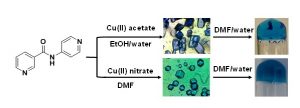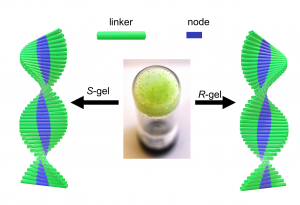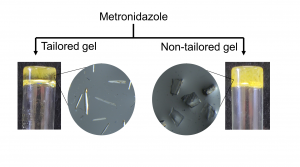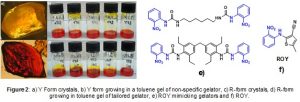Supramolecular Gels
Gels are ubiquitous solid-like materials found in everyday applications such as contact lenses, lithium grease, jelly and hair gels. While most gels are based on polymeric components, this is growing recent interest in a class of gelators termed low molecular weight gelators (LMWG) that are based on small molecular species that form gel fibres by supramolecular interactions such as hydrogen bonding and hydrophobic effects due to their intriguing applcations. We have synthesized and characterized various hydrogen-bond functionalized gelators based on amide- (Angew. Chem. Int. Ed., 2021, 60, 24406-24410, Chem Matter, 2020, 32, 8, 3517-3527) urea- (Cryst. Growth Des. 2021, 21, 9, 5383–5393, Molecules, 2021, 26(21), 6420, Langmuir 2018, 34, 12957−12967) and hydrazone-moieties (CrystEngComm, 2021, 23, 617-628)
Multi-component gels
Multi-component gels based on enantiomers were prepared by mixing the equal amount of pure enantiomers as well as varying individual enantiomer concentrations Langmuir 2018, 34, 12957−12967. We have studied the self-assembly process of multicomponent gel based on enantiomers and reported the first crystallographic evidence of specific co-assembly in mixed enantiomeric gel, which was supported by scanning electron microscopy and atomic force microscopy images. The mode of interactions between the individual gelators from the molecular to macroscopic level, which were responsible for co-assembled fibers, was identified by single-crystal X-ray diffraction. We have proved that specific co-assembly leads to enhanced mechanical and thermal stability in the mixed gel compared to the meso and individual enantiomeric gels Chem Matter, 2020, 32, 8, 3517-3527.
Applications of Supramolecular gels
1. Reaction media
We reported the gel phase synthesis of metal–organic materials (MOMs) to generate homochiral MOMs, which were characterized by single crystal X-ray diffraction. The chirality of the gelator dictated the handedness of the MOMs and the enantioselectivity was confirmed by solid-state circular dichroism experiments. Angew. Chem. Int. Ed., 2021, 60, 24406-24410,
2. Crystalizing media
We have used suprmolecular gels as a crsyllizing media for varoious organic and inorgnaic compound.
We have used supramolecular gels as a crystallizing media for various organic and inorganic compounds. We have shown LMWGs that are structurally similar to crystallisation substrate will enable selective crystallisation of the particular polymorphs of metronidazole Cryst. Growth Des. 2021, 21, 9, 5383–5393.
In collaboration with Steed´s group, we reported the synthesis of a bis(urea) gelator designed to specifically mimic the chemical structure of the highly polymorphic drug substance ROY. In this work, we have shown LMWGs that are structurally similar to crystallisation substrate will enable selective crystallisation of the particular polymorphs.Chem. Sci., 2017, 8, 78-84
We have extended this technique to inorganic complexes and have isolated different forms of copper(II) isonicotinate-N-oxide complex and studied their phase interconversion via solvent-mediated crystal to crystal transformation. Gel phase crystallisation performed in hydrogels, low molecular weight gels and gels of tailored gelators showed crystal habit modification. Crystallisation in aqueous ethanol resulted in concomitant formation of blue (form-I) and green (form-II/IV) crystals while use of LMWGs (Val-TMA) results in selective crystallisation of the blue form-I under identical conditions New. J. Chem, 2018, 42, 19963 - 19970.
We have reported the gelation ability of metallogels based on metal complexes of N-(4-pyridyl)nicotinamide (4PNA) and the studies revealed that copper(II) complexes of 4PNA formed gels selectively. In this study, we have proved the existence of crystalline state in the supramolecular gel matrix. The formation of crystalline materials in gel state is very important due to the potential applications in utilising LMWGs as cell growth media and a medium to control crystal growth CrystEngComm, 2015, 17, 8130-8138
 3. Sensors.
3. Sensors.
Making and Breaking of Gels: Stimuli-Responsive Properties of Bis(Pyridyl-N-oxide Urea) Gelators, Molecules, 2021, 26(21), 6420
Metal complexation induced supramolecular gels for the detection of cyanide in water, Supramol. Chem. 2020, 32, 4, 276-286




